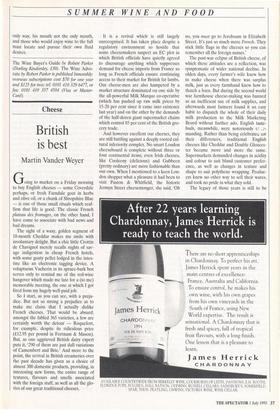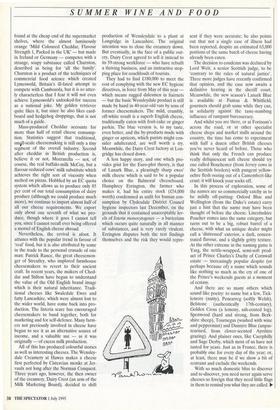Cheese
British is best
Martin Vander Weyer
Going to market on a Friday morning to buy English cheeses — some Coverdale perhaps, or fresh Farndale goat in herbs and olive oil, or a chunk of Shropshire Blue — is one of those small rituals which reaf- firm that life is good. The classic French plateau des fromages, on the other hand, I have come to associate with bad news and bad dreams.
The sight of a waxy, golden segment of 18-month Cheddar makes me smile with involuntary delight. But a chic little Crottin de Chavignol merely recalls nights of sav- age indigestion in cheap French hotels, with some goaty pellet lodged in the intes- tine like an electronic tagging device. A voluptuous Vacherin in its spruce-bark box serves only to remind me of the red-wine hangover which made me late for a (to me) memorable meeting, the one at which I got fired from my hugely well-paid job.
So I start, as you can see, with a preju- dice. But not so strong a prejudice as to make me claim that I actually dislike French cheeses. That would be absurd; amongst the fabled 365 varieties, a few are certainly worth the detour — Roquefort, for example, despite its ridiculous price (£12.95 per pound in Fortnum & Mason). But, as one aggrieved British dairy expert puts it, '290 of them are just dull variations of Camembert and Brie.' And more to the point, the revival in British creameries over the past decade has given us a choice of almost 300 domestic products, providing, in interesting new forms, the entire range of textures, flavours and smells associated with the foreign stuff, as well as all the glo- ries of our great traditional cheeses.
It is a revival which is still largely unrecognised. It has taken place despite a regulatory environment so hostile that some cheesemakers suspect an EC plot in which British officials have quietly agreed to discourage anything which suppresses demand for cheese imports from France so long as French officials ensure continuing access to their market for British fat lambs. Our cheese-men are also hampered by a market structure dominated on one side by the all-powerful Milk Marque co-operative (which has pushed up raw milk prices by 15-20 per cent since it came into existence last year) and on the other by the demands of the half-dozen giant supermarket chains which control 85 per cent of the British gro- cery trade.
And however excellent our cheeses, they are still battling against a deeply rooted cul- tural inferiority complex. No smart London cheeseboard is complete without three or four continental items; even Irish cheeses, like Cooleeny (delicious) and Gubbeen (pretty ordinary) are more fashionable than our own. When I mentioned to a keen Lon- don shopper what a pleasure it had been to visit Paxton & Whitfield, the historic Jermyn Street cheesemonger, she said, 'Oh
no, you must go to Jeroboam in Elizabeth Street. It's just so much more French. They stick little flags in the cheeses so you can remember all the foreign names.'
The post-war eclipse of British cheese, of which these attitudes are a reflection, was symptomatic of wider national decline. In olden days, every farmer's wife knew how to make cheese when there was surplus milk, just as every farmhand knew how to thatch a barn. But during the second world war farmhouse cheese-making was banned as an inefficient use of milk supplies, and afterwards most farmers found it an easy habit to dispatch the whole of their daily milk production to the Milk Marketing Board without further ado. English taste- buds, meanwhile, were notoriously ur ..:- madding. Rather than being celebrates tor their differences, traditional English cheeses like Cheddar and Double Glouces- ter became more and more the same. Supermarkets demanded changes in acidity and colour to suit bland customer prefer- ence, as well as changes in texture and shape to suit polythene wrapping. Produc- ers knew no other way to sell their wares, and took no pride in what they sold.
The legacy of those years is still to be found at the cheap end of the supermarket shelves, where the almost luminously orange `Mild Coloured Cheddar, Flavour Strength 1, Packed in the UK' — but made in Ireland or Germany — competes with a strange, soapy substance called Churnton, described as being for `all the family'. Churnton is a product of the techniques of commercial food science which created Lymeswold, Britain's ill-fated attempt to compete with Cambozola, but it is so utter- ly characterless that I fear it will not even achieve Lymeswold's unlooked-for success as a national joke. My golden retriever quite likes it, but since he also likes card- board and hedgehog droppings, that is not much of a guide.
Mass-produced Cheddar accounts for more than half of retail cheese consump- tion. Statistics suggest that traditional, smoll-scale cheesemaking is still only a tiny segment of the overall industry. Second after cheddar in British production is, believe it or not, Mozzarella — not, of course, the real buffalo-milk McCoy, but a flavour-reduced cows' milk substitute which achieves the right sort of viscosity when melted on pizzas. Hobbled by an EC quota system which allows us to produce only 85 per cent of our total consumption of dairy produce (although we could produce much more), we continue to import almost half of all our cheese requirements. We export only about one seventh of what we pro- duce, though where it goes I cannot tell you, since I cannot recall ever being offered a morsel of English cheese abroad.
Nevertheless, the revival is afoot. It attunes with the popular trend in favour of `real' food, but it is also attributed by some in the trade to the personal crusade of one man: Patrick Rance, the great cheesemon- ger of Streatley, who implored farmhouse cheesemakers to revert to their ancient craft. In recent years, the makers of Ched- dar and Stilton have begun to understand the value of the Old English brand image which is their natural inheritance. Tradi- tional cheeses like Swaledale Ewes and fatty Lancashire, which were almost lost to the wider world, have come back into pro- duction. The listeria scare has encouraged cheesemakers to band together, both for marketing and for self-defence. Many farm- ers not previously involved in cheese have begun to see it as an alternative source of income, and a valuable use — as it was originally — of excess milk production.
All of this has produced colourful stories as well as interesting cheeses. The Wensley- dale Creamery at Hawes makes a cheese first perfected by Cistercian monks at Jer- vaulx not long after the Norman Conquest. Three years ago, however, the then owner of the creamery, Dairy Crest (an arm of the Milk Marketing Board), decided to shift production of Wensleydale to a plant at Longridge in Lancashire. The original intention was to close the creamery down. But eventually, in the face of a public out- cry, Dairy Crest agreed to sell it instead to its 59-strong workforce — who have rebuilt a thriving business, and an instructive stop- ping place for coachloads of tourists.
They had to find £180,000 to meet the cost of complying with the new EC hygiene directives, in force from May of this year which means rugged dalesmen in hairnets — but the basic Wensleydale product is still made by hand in 40-year-old vats by sons of former cheesemakers. The mild, crumbly, off-white result is a superb English cheese, traditionally eaten with fruit-cake or ginger parkin. The blue version is, to my taste, even better, and the by-products made with ginger or apricots, which purists might con- sider adulterated, are well worth a try. Meanwhile, the Dairy Crest factory at Lon- gridge has closed down.
A less happy story, and one which pro- vides grist for the Euro-plot theory, is that of Lanark Blue, a pleasingly sharp ewes' milk cheese which is said to be a popular choice on the Balmoral cheeseboard. Humphrey Errington, the farmer who makes it, had his entire stock (£54,000 worth) condemned as unfit for human con- sumption by Clydesdale District Council hygiene inspectors last December, on the grounds that it contained unacceptable lev- els of listeria monocytogenes — a bacterium which occurs quite naturally in all manner of substances, and is very rarely virulent. Errington disputes both the test findings themselves and the risk they would repre- sent if they were accurate; he also points out that not a single case of illness had been reported, despite an estimated 63,000 portions of the same batch of cheese having already been eaten.
The decision to condemn was declared by Lord Weir, a senior Scottish judge, to be `contrary to the rules of natural justice'.
Three more judges have recently confirmed that opinion, and the case now awaits a definitive hearing in the sheriff court.
Meanwhile, the new season's Lanark Blue is available at Paxton & Whitfield; gourmets should grab some while they can, in solidarity against the taste-numbing influence of rampant bureaucracy.
And whilst you are there, or at Fortnum's across the road, or at other specialist cheese shops and market stalls around the country, the time has come to experiment with half a dozen other British cheeses you've never heard of before. Those who think that only the French can produce really deliquescent soft cheese should try one called Bonchester (from Jersey cows in the Scottish borders) with pungent yellow- ochre flesh oozing out of a Camembert-like crust; it will knock your socks off.
In this process of exploration, some of the names are so commercially catchy as to be mildly off-putting: Oxford Blue and Wellington (from the Duke's estate) carry just a hint that the name may have been thought of before the cheese. Lincolnshire Poacher comes into the same category, but turns out to be a big, robust barrel of a cheese, with what an antique dealer might call a 'distressed' exterior, a dark, concen- trated flavour, and a slightly gritty texture.
At the other extreme in the naming game is Yarg, the nettle-wrapped, semi-soft prod- uct of Prince Charles's Duchy of Cornwall estate — increasingly popular despite (or perhaps because of) a name which sounds like nothing so much as the cry of one of the Prince's weekends guests at a moment of ecstasy.
And there are so many others which sound like poetry: to name but a few, Tick- lemore (nutty), Pencarreg (softly Welsh), Belstone (authentically 17th-century), Golden Cross (a lemony, ash-coated log), Spenwood (hard and strong, from Berk- shire sheep), Tournegus (washed with wine and peppermint) and Dunsyre Blue (unpas- teurised, from clover-scented Ayrshire grazing). And plainer ones, like Caerphilly and Sage Derby, which most of us have not tasted for years. Just as in France, there is probably one for every day of the year; or, at least, there may be if we show a bit of restraint and exclude the weekends.
With so much domestic bliss to discover and re-discover, you need never again serve cheeses so foreign that they need little flags in them to remind you what they are called. ■



































































 Previous page
Previous page